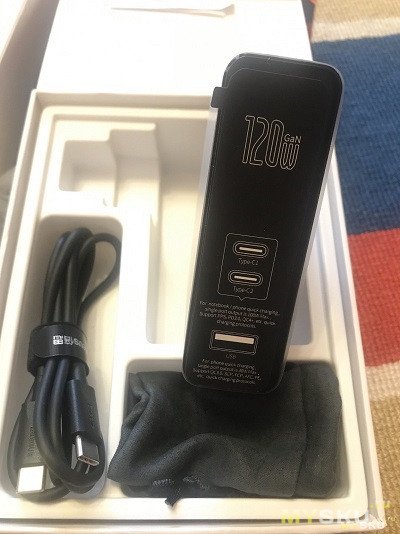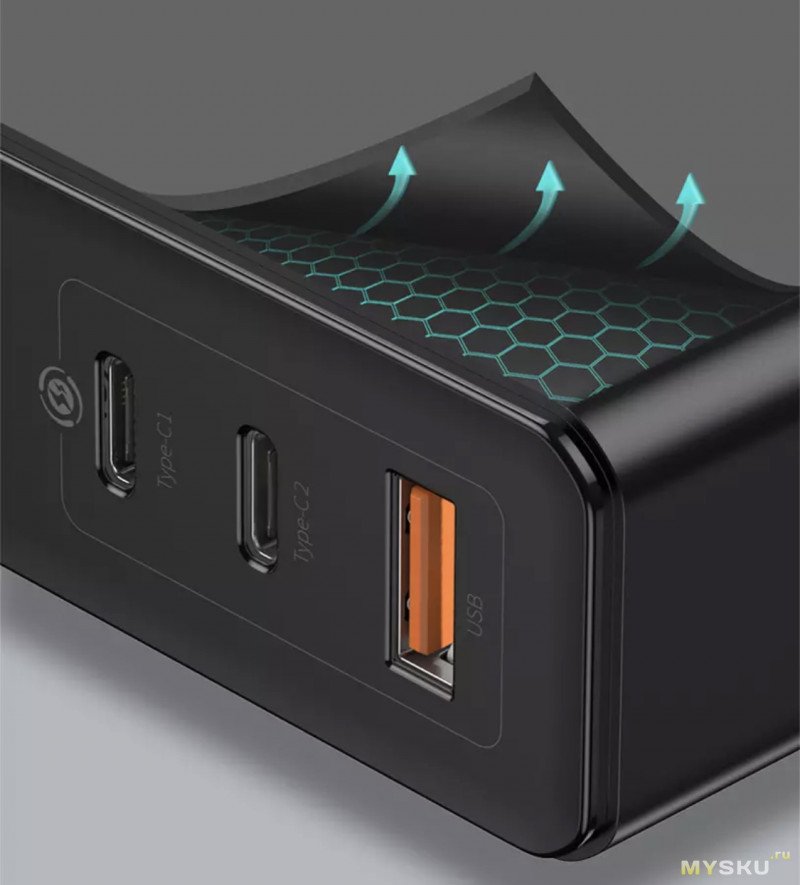4. From here, it turns out, the presence of a second Type-C port at 60W is explained while simultaneously loading two Type-Cs from the product in the review.
Dimensions – 93x28x54 mm, volume – 140.6 cm3. Type2-C: 3.3-20V/5A, 5V/3A, 9V/3A, 12V/3A, 15V/3A, 20V/5A (in fact, the maximum is 103W)
120W charger from Baseus: Galio project
 Type2-C 5V/3A, 9V/3A, 12V/2.5A, 15V/2A, 20V/1.5A 5. Switching occurs in any case, which I don’t like, since all reputable companies got rid of breaks in their power supplies a long time ago. USB-A: 4.5V/5A, 5V/4.5A, 5V/3A, 9V/3A, 12V/2.5A, 20V/1.5A 6. The dimensions of the charging unit on the review are shown in the photo:
Type2-C 5V/3A, 9V/3A, 12V/2.5A, 15V/2A, 20V/1.5A 5. Switching occurs in any case, which I don’t like, since all reputable companies got rid of breaks in their power supplies a long time ago. USB-A: 4.5V/5A, 5V/4.5A, 5V/3A, 9V/3A, 12V/2.5A, 20V/1.5A 6. The dimensions of the charging unit on the review are shown in the photo:
Galio is twice as big as the first GaN from Baseus, but almost twice as powerful. USB-A: 4.5V/5A, 5V/4.5A, 5V/3A, 9V/3A, 12V/2.5A, 20V/1.5A The Baseus 120W (Galio) model, made using gallium nitride and silicon carbide (GaN and SiC), is able to satisfy practically all requests. Type1-C Type2-C2: 60W 60W The third technology is BCT (Baseus Cooling Technology), which consists of a special nano-layer applied to the body of the charger, which ensures rapid heat distribution from the https://jiji.com.gh/computers-and-laptops/17_inch radiator. 1.Type1-C: 3.3-20V/5A, 5V/3A, 9V/3A, 12V/3A, 15V/3A, 20V/5A (in fact, the maximum is 88W ) Without silicon carbide, Galio would just be 65W GaN from Baseus. 4.1.
Based on technology, Galio should differ from Baseus 65W GaN in more power, smart switching system and less heat. 2. Confirmation of modes by a tester and trigger: Silicon carbide withstands high temperatures, up to 1500°C. This is the largest of all GaN chargers: both 65W GaN from Baseus (70.4 cm3), and GaN from ANKER model A2322 (121.2 cm3), and 100W GaN Choetech (121.9 cm3), but less than the volume of 100W Wotobe ( 156.2 cm3), which was given for comparison in the Choetech review. 4.2.
Relative to a standard 120W charger from a laptop, the dimensions of the PSU are much smaller: Type1-C/Type2-C: 5V/3A, 9V/3A,12V/3A, 15V/3A, 20V/4.35A Type1-C 5V/3A, 9V/3A, 12V/3A, 15V/3A, 20V/3A USB-A: 4.5V/5A, 5V/4.5A, 5V/3A, 9V/3A, 12V/2.5A, 20V/1.5A The explanation for this is that consumers need smaller chargers that can charge both laptops and phones quickly (using fast protocols at the same time). Baseus, along with gallium nitride, also uses silicon carbide (carborundum) in microcircuits to increase the frequency on the transformer, which, in turn, gives more power with unchanged dimensions. Support is declared:
Type2-C: 5V/3A, 9V/3A,12V/3A, 15V/3A, 20V/3A There are many modes, the most interesting of which is full load .  The increase in power relative to analogues is greater than the increase in volume. The second technology is the Baseus Power Split II mode switching technology. 5.2. Supported protocols: Also, its use is due to the presence of a wide bandgap in semiconductors (an energy range that charge carriers cannot have). 3. In this case, the larger size increased the power. 6.3. Wide-gap semiconductors can operate at higher temperatures and voltages and be controllable. It doesn’t matter which port is used and which wire is added to. 6.1. The current direction of the charger market is entirely dependent on marketing, which forces chargers to become smaller and more powerful. It consists in the intelligent distribution of current, voltage and power to accurately charge devices individually and when fully loaded. Type1-C: 5V/3A, 9V/3A,12V/3A, 15V/3A, 20V/3A 6.2. Type1-C/Type2-C USB-A: 87W 30W It looks like this: It’s good when you can charge several laptops with such chargers. As part of the tests for loading outputs, one cannot fail to mention the gaps that, unfortunately, the charging has. 5.1.
The increase in power relative to analogues is greater than the increase in volume. The second technology is the Baseus Power Split II mode switching technology. 5.2. Supported protocols: Also, its use is due to the presence of a wide bandgap in semiconductors (an energy range that charge carriers cannot have). 3. In this case, the larger size increased the power. 6.3. Wide-gap semiconductors can operate at higher temperatures and voltages and be controllable. It doesn’t matter which port is used and which wire is added to. 6.1. The current direction of the charger market is entirely dependent on marketing, which forces chargers to become smaller and more powerful. It consists in the intelligent distribution of current, voltage and power to accurately charge devices individually and when fully loaded. Type1-C: 5V/3A, 9V/3A,12V/3A, 15V/3A, 20V/3A 6.2. Type1-C/Type2-C USB-A: 87W 30W It looks like this: It’s good when you can charge several laptops with such chargers. As part of the tests for loading outputs, one cannot fail to mention the gaps that, unfortunately, the charging has. 5.1.
Each Type-C port supports up to 100W individually, simultaneously – 60W each, and a combination of Type-C and Type-A – up to 87W (photo Type2-C and USB-A at 87W not shown to save space). 
Via Type-C, you can charge not only via PD, but also phones via QC, MTK PE "fast" protocols.
The difference is more than 2 (316.2 versus 140.6 cm3) in favor of the Baseus PSU. The following modes are declared: Type1-C Type2-C USB-A: 60W 30W 30W
